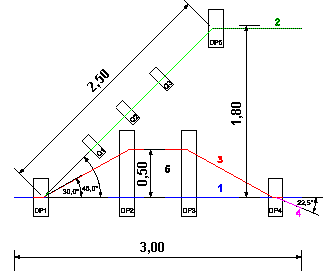|
The beam transport to the FELs has to perform a bunch compression and
for that a chicane was planned between LINAC 1 and the S-arc.
To design it the required transport matrix element R56 should be determined. This
value depends on the longitudinal phase space after LINAC 1
and the desired longitudinal phase space in the FELs. Due to
the complexity of the problem no exact values could be
obtained from numerical simulations. As an estimate of the
maximum required R56 a value of 450 mm was fixed. A variable
chicane is planned which allows to vary R56 from 0 to this maximum.
This gives an enormous flexibility in connection with LINAC 2,
which for instance makes it possible to measure the longitudinal
phase space.
To allow two-colour experiments at ELBE with
two FELs running synchronously in the future the beam transport has to be suitably
designed. Even if these steps are not realized now the
needed place for them has to be reserved. Because of tight
space there is no other possibility than to combine the
variable chicane with the beam separation for two-colour
experiments and the beam transport to the nuclear physics
experiments. A side effect of such a combination is the saving
of extra dipoles for these tasks. As a consequence the size of
the chicane is completely determined by the geometry resulting
from the deflection angles of both energies at two-colour
experiments. These angles were set to 30 and 45 degrees
corresponding to a RF induced energy modulation of ± 5.23 MeV
for a 30 MeV beam. This results in an even higher maximum R56
of the chicane of 633 mm with a maximum beam offset of 513 mm
in its center. In Fig. 1 an overview of the chicane with the
combined beam separation is given.
There exist five different beam paths in this design:

Fig. 1: Design of beam separation combined with variable
chicane
|
| 1 - | Straight through to the radiation |
| physics and neutron physics caves |
| (all dipoles off). |
| 2 - | A separate path for the beams with |
| sufficiently low energy. |
| 3 - | A path for the higher energy beam |
| back to the continuation of line 1. For |
| two-colour experiments this path and |
| path 2 are used alternatively by sub- |
| sequent pulses. |
| 4 - | A beam path to the nuclear physics |
| cave (only dipole 4 switched on). |
| 5 - | A variable beam path for normal |
| chicane operation. |
|
Beam transport calculations for all five beam paths were performed
and it is possible to match the beam to the different
requirements. The position of the viewscreens and beam
adjustment rules are defined.
FWF
05/18/01
© A. Büchner
|
